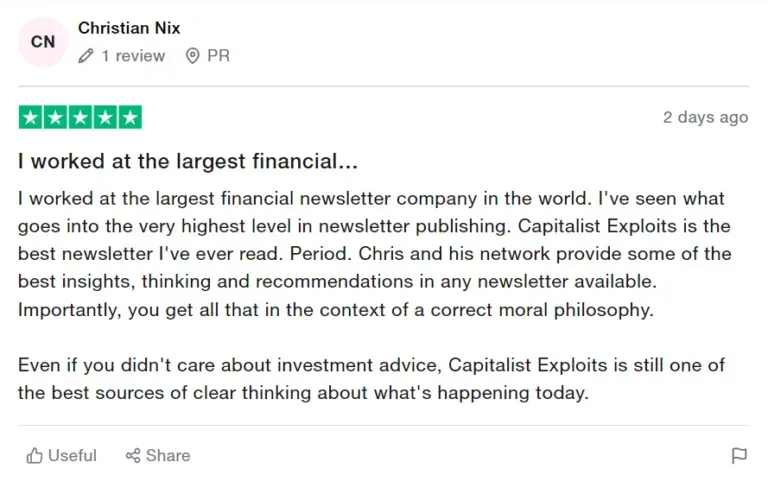Chris Macintosh: The Mastermind Behind Capitalist Exploits
Few people can match the expertise and experience of Hedge Fund Manager Chris Macintosh.
A renowned analyst, speaker, and deep-value investor, Macintosh is the founder and CEO of Capitalist Exploits, a company that provides investment insights and opportunities to investors worldwide.
With over two decades of experience in finance and investing, Macintosh has worked in various roles such as a stock broker, fund manager, and investment banker.
He has seen it all - from market crashes to economic booms - and has developed a unique perspective on how to navigate the often-turbulent waters of the financial markets.
Contrarian Investing Approach
One of the things that sets Macintosh apart from other investors is his contrarian approach to investing.
Instead of following the herd mentality that often leads to losses in the market, he looks for opportunities that others might overlook or dismiss.
This approach has proven successful time and time again. In fact, many investors who have followed his advice have achieved significant returns on their investments.
Media Appearances
Macintosh's expertise in finance and investing has not gone unnoticed by the media.
He has been mentioned in several independent media outlets such as International Man, and Zerohedge and on podcasts like the Rebel Capitalist Show.
These appearances have helped cement his reputation as one of the foremost experts in the field of deep value investing.
It's no wonder why so many people turn to him for guidance when it comes to making investment decisions.
Insider Newsletter Gives You Investment Ideas You Will Not Get From Mainstream Talking Heads
Unlock Market Secrets: 30 Days of Insider Newsletter for Just $1!
Tired of missing out on the best investment opportunities? Capitalist Exploits is here to change the game.
Founded by industry veterans Chris MacIntosh and Brad McFadden, the Insider Newsletter delivers exclusive investment insights that are normally reserved for the elite. This isn’t your typical advice—you’ll get access to opportunities other investors never even hear about.
Why stay in the dark when you can get ahead of the market? For just $1, you can experience 30 days of insider knowledge that could transform your investment strategy. Don’t settle for outdated stock picks and generic advice—*capitalize on a unique perspective that could change the way you invest*.
Your advantage starts now! Subscribe today for just $1 and gain 30 days of premium access. Time to seize your edge in the market!

"Not many people could lay out convincing ways to play the COVID crisis. I manage my family's wealth, and Insider Newsletter has been an invaluable tool in positioning my family for the future - ideas each week that are long-term and deep value. I read each issue at least twice."
—
John D. Family, Office Manager
Who's Behind Capitalist Exploits?

Chris MacIntosh
Founder, Insider
There are few people who can match the expertise and experience of Chris Macintosh.
A renowned author, speaker, and investor, Macintosh is the founder and CEO of Capitalist Exploits, a company that provides investment insights and opportunities to investors from all over the world.
With over two decades of experience in finance and investing, Macintosh has worked in various roles such as a stockbroker, fund manager, and investment banker.
He has seen it all - from market crashes to economic booms - and has developed a unique perspective on how to navigate the often-turbulent waters of the financial markets.

Bradd McFadden
Lead Trader, Insider
After managing high net worth private client funds at Henry Ansbacher, and a proprietary trading book for Rand Merchant Bank in South Africa & Australia, Brad specializes in execution of the asymmetric opportunities delivered via Insider.




What subscribers are saying...


Jared G
"I am happy I found Capitalist Exploits! I am a professional investor with many years of experience, but I am still learning A LOT by reading Chris’s posts and listening to his webcasts. Very honest approach. Intellectually sound. No annoying marketing that plagues so many other “investment letter” providers from the US." Thank you!


Benton N
"My top newsletter. Top asymmetric trades with huge upsides, low downside and help bulletproof your portfolio. Not for get rich quickers, this takes time and study. The team at Capitalist Exploits is the best in the business and truly care about their subscribers."


Keith L
Capitalist Exploits is a fantastic research resource. Well researched, thought out, and presented thematic investment ideas with actionable trade recommendations. Add that to an incredibly entertaining writing style and you have a publication I look forward to every day. Bottom line they have made me a lot of $.


Andre V
I’ve been an investor for over 20 years. Subscribed to a few investment newsletters over that time. This is by far the best service I’ve come across. The research is thorough, well thought out and presented in a clear way. This is not for those looking to get rich quickly. This is for those looking to get in before the crowd. Wayne Gretzky said, “I skate to where the puck is going to be, not where it has been.” The same principle applies to investing. You will not be disappointed.
Get Regular Stock Ideas From Full-Time Money Managers
Are you looking for new investment opportunities? Start with the Newsletter, then ascend to the Insider Membership when you are ready!
Insider Newsletter is a service that provides you with regular stock ideas from full-time money managers. Chris MacInthosh is committed to finding the best stocks for his subscribers. He has a network of experienced analysts and fellow money managers who spend as much time as he does researching each company mentioned in Insider.
With Insider Newsletter, you will have access to information and analysis that most individual investors don’t have. This will help you make more informed investment decisions and increase your chances of achieving your financial goals.
The Current Global Crisis Is Your Chance to Build Generational Wealth!
If you are self-directing your longterm stock portolio, then we highly recommend you first enroll in the free Asymmetric Investing Course to understand the Capitalist Exploits investing philosophy, then subscribe to the newsletter. If you are a serious player who needs access to model portfolio's and Chris or Bradd, then sign up for Capitalist Insider.

Skin in the Game
The concept of "Skin in the Game" is a crucial aspect of any venture or investment. It refers to having a personal stake in the outcome, which aligns incentives and ensures accountability.
This principle is especially relevant to capitalist exploits, where taking calculated risks in the market can lead to significant gains.
By putting your own money on the line, you become fully invested in the outcome and are more likely to make informed decisions based on careful analysis and risk management strategies.
Joining a trial or team offered by a reputable company or guru can provide valuable expertise and guidance while also allowing you to benefit from their risk management strategies.
Aligning Incentives
When you have skin in the game, your interests are aligned with those of other stakeholders.
This alignment creates an environment where everyone involved has a vested interest in achieving success.
While investing, you are more likely to make informed decisions prioritizing long-term gains over short-term profits.
Having skin in the game also ensures accountability. When you have something at stake, you are more likely to take responsibility for your actions and work harder towards achieving your goals.
Taking Calculated Risks
Risk-taking is an essential part of trading and investing. However, it's important to note that not all risks are created equal.
By having skin in the game, you're more likely to take calculated risks that offer high potential rewards while minimizing potential losses.
Joining a Capitalist Exploits can provide valuable insights into risk management strategies.
By learning from experienced traders who have already navigated similar situations successfully, you'll be better equipped to make informed decisions that maximize your chances of success.
Focus on Sectors, Not Stocks
Investing in sectors rather than individual stocks can be smart for investors looking to reduce risk and increase returns. This is fundamental to the asymmetric investing strategy.
By focusing on sectors, investors are able to diversify their portfolios and take advantage of broader market trends rather than relying on the performance of a single stock.
When building their portfolios, professional money managers like Chris and Bradd focus on sectors or themes rather than individual stock picks.
This approach allows them to spread their investments across multiple companies within a particular sector, reducing the impact of any one company's poor performance.
Investment recommendations and advice from hedge fund managers like Chris also tend to emphasize sector-specific investment ideas.
These experts spend countless hours researching different industries and analyzing global market trends to identify opportunities for growth and profit.
Conducting investment research on specific sectors can provide a better understanding of global markets and investment opportunities.
By studying the financial markets, investors can gain insight into which sectors are likely to perform well in the future based on economic indicators such as GDP growth rates, interest rates, and inflation.
Paper trading or practicing with virtual portfolios can help investors test their investment strategy and sector-specific recommendations before investing real money.
This approach allows investors to experiment with different investment strategies without risking any actual capital.
Historically, certain sectors, such as Asia markets, have provided higher annual returns compared to others, making them attractive for long-term investment.
For example, over the past decade, Asian markets have outperformed other regions due to strong economic growth fueled by rising middle-class incomes and increased consumer spending.
There are several factors that investors should consider. One important factor is the company's financial health, including its revenue growth rate, profitability margins, debt levels, and cash flow generation capacity.
Another important factor is the company's competitive position within its industry.
Investors should look for companies that have a sustainable competitive advantage over their rivals through factors such as brand recognition, intellectual property rights or proprietary technology.
Investors should also consider the company's valuation relative to its peers and historical averages.
A company that is trading at a significant discount to its peers or historical averages may represent an attractive investment opportunity.
In addition to these fundamental factors, investors should also pay attention to technical indicators such as price momentum, moving averages, and relative strength index (RSI) when selecting individual stocks within a sector.
Subscription Options: Insider Newsletter, and Insider Membership
Capitalist Exploits currently offers two subscription services for their subscribers: The Insider Newsletter, and Insider Membership.
Each option provides unique benefits that cater to different investment needs and preferences.
In this section, we will discuss each subscription option in detail.
Insider Newsletter
Insider Newsletter delivers updates on global macroeconomic trends and investment opportunities every 7-10 days.
This newsletter is perfect for investors wanting to stay current on global macro, geo-political, financial trends, and sector and company recommendations.
The Insider newsletter covers a wide range of topics, including international politics, central bank policies, trade agreements, and market trends.
Subscribers receive expert analysis on each topic, along with actionable investment recommendations.
In addition to the weekly newsletter, subscribers also access special reports covering specific topics in greater detail.
Recent reports have covered topics such as cryptocurrency investing and emerging market opportunities.
Insider Membership
Insider Membership is Capitalist Exploits' most comprehensive subscription option. It includes the Insider Newsletter subscription service, access to a members-only chat room, model portfolios, Q&As, education, and exclusive investment research.
By subscribing to Insider Membership, members get access to all the benefits of the Insider newsletter, but they also get access to a model portfolio of stocks.
The members-only chat room allows subscribers to connect with other like-minded investors and industry experts. Members can share ideas, ask questions, and get feedback on potential investments.
Exclusive investment research is another benefit of Insider Membership. Chris and the team conduct in-depth research on specific industries and investment opportunities. This research is only available to Insider Membership subscribers.
Something For All Levels
Capitalist Exploits Helps You Protect & Grow Your Wealth in Many Ways
Free Asymmetric Investing Course
Discover the secret to achieving high returns, with low risk.
Learn how to target sectors with massive upside potential and limited downside.
Spot capital flows and invest in undervalued sectors before they take off.
Build a balanced portfolio with small positions across high-growth industries.
Insider Newsletter
Unlock Unmatched Market Insights: Stop relying on mainstream advice and discover long-term strategies from experts who invest in what they recommend.
Maximize Gains, Minimize Risk: Learn to invest in sectors ignored by the herd and secure returns the market can’t offer.
No Gimmicks, Just Results: Proven performance with real research and a straightforward approach that outperforms the market.
Invest with Confidence: Get access to timely, actionable strategies backed by thorough research and expert insights.
Rebel Capitalist Pro
Access Elite Market Insights: Get exclusive strategies from top macro investors like Lyn Alden and Chris MacIntosh—insights not available to the average investor.
Premium Newsletters by Lyn Alden and Chris MacIntosh. Includes audio versions.
Weekly Q&As with Experts: Interact live with industry leaders and get your pressing investment questions answered by those who’ve navigated volatile markets for decades.
7-Day Trial for Just $1: Try it risk-free and discover how you can transform your investment approach with only $1!
Join Insider (Full Membership)
Asymmetric Gains Portfolio
US markets based portfolio
Diversified Income Portfolio
Full Guidance On Buying/Selling
Weekly Commentary / Stock Tips
Monthly Member Q&A Webinar
Insider Community Forum
International focus
30 Day Money Back Guarantee
Glenorchy Rebel Fund (Private Fund)
For Accredited Investors Only!
Deep Value, Asymmetric, Reduces Risk
Invest in extremely out of favour sectors that are fundamentally mispriced, and are poised for growth.
Join Chris, Brad, and George Gammon on this critical journey and start reaping the rewards of becoming a Rebel Fund Investor.

What subscribers are saying about Capitalist Exploits investing service


Tom W
Capitalist Exploits is seriously just great service and community. You get WAY more bang for your buck than any other investment research service. Weekly letters, monthly webinars, boatloads of ideas, education, humor, entertainment, and a great community to interact with online.


Harry B
If you are paying $2,000 to $4,000 a year for a newsletter that posts once MAYBE twice a month you are getting scammed IMO, Capitalist Exploits is NOT that kind of service. Honestly, I can’t say enough good things about Chris & Crew."


Robert C
“Worth 50-100x the Cost. Easy. Great material. I love it. The research coincides with my own investing style and when there’s an overlap I put down 2-3x what I would.
This is the kind of research you want to be paying for year after year for decades because it introduces you to new things. Great for people with no time to be fully exposed to everything going on out there.
It took me 45-50 days to make back my investment in the course in profit on positions."


Mark S
Capitalist Exploits is a fantastic research resource. Well researched, thought out, and presented thematic investment ideas with actionable trade recommendations. Add that to an incredibly entertaining writing style and you have a publication I look forward to every day. Bottom line they have made me a lot of $.
Risks of Investing Using Capitalist Exploits Information
Investing in the stock market is a popular way to grow wealth and secure financial stability. However, not all investment opportunities are created equal.
Capitalist Exploits is not a guaranteed investment opportunity. The stock market is inherently volatile, and even with insider knowledge, there is no guarantee of success. The Capitalist Exploits team may have a unique insight, but this does not guarantee your success.
Personal investments made by way of commentary provided by Capitalist Exploits should be carefully considered and researched before investing. Investors should do their due diligence and research the company's history, performance, and reputation before investing any money.
Investors should also be prepared to potentially lose money when investing through commentary provided by Capitalist Exploits or any other investment service. The stock market can be unpredictable, and even with careful research and planning, there is always a risk of losing money.
It is important for investors to diversify their investment portfolio. Diversification helps spread out risk across different types of investments and can help protect against potential losses.




© Copyright 2025. CapitalistExploitsReview.com. This website is for information purposes only.
Affiliate Disclaimer: CapitalistExploitsReview.com is an independent review site that may receive compensation from the products and services featured on this site, including from Capitalist Exploits. Our opinions are our own and are not influenced by affiliate relationships. We only recommend products we believe in, but please conduct your own research before making any purchasing decisions.


